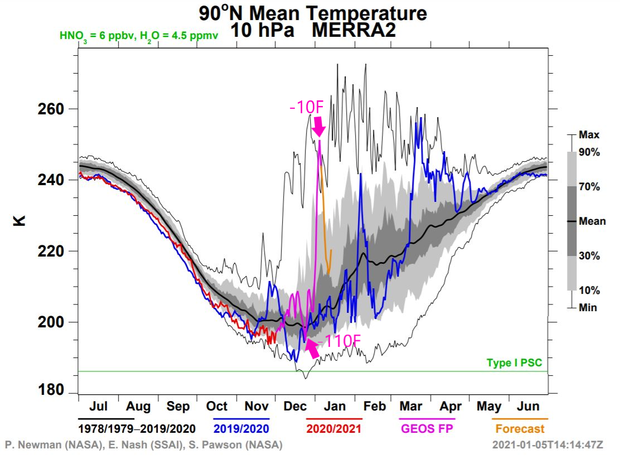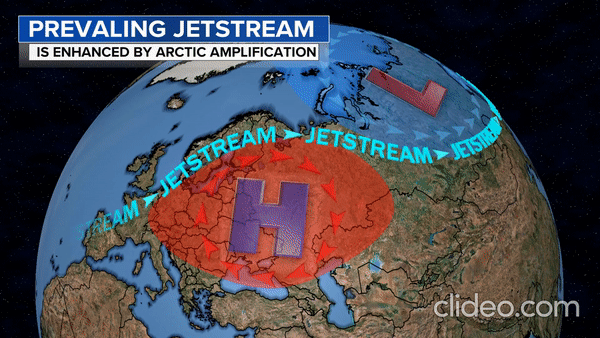He says the beginnings of the sudden warming in the stratosphere starts much closer to the ground, in a layer of the atmosphere called the troposphere. But in order for this abrupt disruption to reach upward from the troposphere into the stratosphere, you need the excess energy of an extreme weather pattern — something that has been in no short supply lately in the Arctic.
When all the numbers are crunched, 2020 will be one of the warmest if not the warmest year on record in the Arctic. This is especially true in northern Asia near the Barents, Kara, Laptev and Siberian Seas, where parts of the region averaged a remarkable 10 degrees Fahrenheit above normal.
https://www.cbsnews.com/news/stratospheric-warming-winter-weather-coming/
Sudden stratospheric warming could mean wild winter storms ahead
By Jeff Berardelli
In the span of a week, from late December to early January, temperatures high in the atmosphere above the Arctic jumped by 100 degrees Fahrenheit. While this may sound alarming, it's a natural phenomenon that happens every couple of years, but experts say human-caused climate change may be making these events more likely.
The remarkable event is called a Sudden Stratospheric Warming (SSW), and it involves the temperatures 50,000 to 100,000 feet above the ground. It disrupts the typical winter climate pattern in the Arctic stratosphere famously known as the polar vortex, and typically leads to more extreme winter weather in parts of the United States.
The polar vortex is a huge low-pressure gyre of cold winds spinning counter-clockwise, which rotate quickly around the Arctic Circle from west to east. But when an SSW occurs, if it is a strong enough event, winds will often reverse and become easterly, and the polar vortex will split into two or three separate vortices, which then drift southward towards the mid-latitudes carrying cold air along with them.
In most cases the SSW propagates down through the clouds to the Earth's surface over the course of a few weeks. When this happens it throws the Arctic upper-level wind patterns off-kilter and the domino effect leads to convoluted jet stream patterns around the world in the mid-latitudes like Canada, the U.S., Europe and Asia. That means it will almost certainly result in some extreme winter weather, and given the expected pattern in the U.S., that will most likely happen along the East Coast.
The SSW that is happening right now is in fact characterized as a "major" event. Since late December temperatures have increased from around minus-110 degrees Fahrenheit to minus-10 degrees — a jump of 100 degrees — at a height of 100,000 feet above the North Pole.
In the image below the purple line shows the abrupt heating this past week, compared to the much flatter black line which is the average temperature.
Causes of sudden stratospheric warming
Dr. Judah Cohen is an expert on sudden stratospheric warming events and the connection between changes in the Arctic and mid-latitude weather patterns at Atmospheric and Environmental Research (AER), a Verisk company.
He says the beginnings of the sudden warming in the stratosphere starts much closer to the ground, in a layer of the atmosphere called the troposphere. But in order for this abrupt disruption to reach upward from the troposphere into the stratosphere, you need the excess energy of an extreme weather pattern — something that has been in no short supply lately in the Arctic.
When all the numbers are crunched, 2020 will be one of the warmest if not the warmest year on record in the Arctic. This is especially true in northern Asia near the Barents, Kara, Laptev and Siberian Seas, where parts of the region averaged a remarkable 10 degrees Fahrenheit above normal.
Even for an Arctic that is warming at three times the pace of the rest of the globe due to climate change — a phenomenon known as Arctic amplification — this is an extreme departure from normal. The result was record-breaking low sea-ice extent near the Siberian coast.
According to Cohen's theory, the lack of sea-ice and the fact that it took a few weeks longer than typical to recover this autumn set into motion a chain of events where the typical prevailing winter jet stream pattern across Asia was enhanced. That enhancement in turn helps initiate the Sudden Stratospheric Warming.
The animation below is an idealized illustration of the effect, in which there is an enhanced heat dome (known as a ridge) over northwest Russia and an enhanced dip in the jet stream (known as a trough) in eastern Asia and the North Pacific.
The jet stream is a river of fast-flowing air in the upper atmosphere which guides storms from one place to another. Just like waves in the ocean, it undulates up and down, from north to south, as it flows around the Earth. These undulations are known as atmospheric waves. And while most of the energy flows around the globe horizontally, some of the wave energy can move vertically, transferring energy upward or downward, especially when those waves are amplified.
Cohen explains that any given time the wave pattern is naturally elongated over Eurasia as compared to the rest of the globe. In a typical pattern this would have no impact on the stratosphere. But when this already large wave becomes even more enhanced by Arctic amplification, the energy in the wave can propagate upward into the stratosphere and cause chaos.
This connection between the warm Arctic, low sea-ice cover and an amplified jet stream is the reason why Cohen believes climate change is leading to more frequent SSWs. But he acknowledges that the topic is controversial.




No comments:
Post a Comment